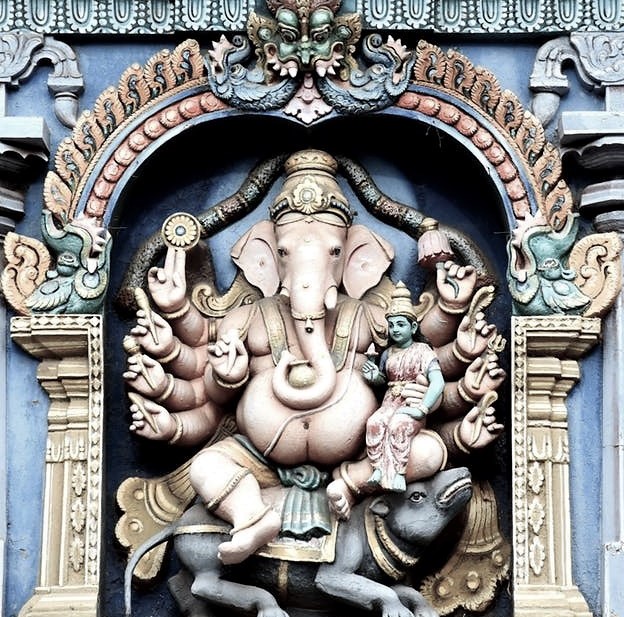- Special FeaturesFoundation YearSthala TreeTheerthamRathamArchitectureOther Speciality
- Sthala Puran
According to Devi Mahabhagwat , Ganga was the elder daughter of Menaka and Himalaya , the elder sister of Parvati and the incarnation of the Supreme Goddess Bhagwati Adishakti Durga.
After her birth, she was taken by Brahma to Brahmaloka in his kamandalu. Then, he washes Lord Vishnu ‘s feet with Ganga water. Hence , from Brahmaloka, she comes to Vaikuntha.
Then, Bhagiratha one of the forefathers of Lord Rama, brought her to earth for attaining salvation of his 60000 ancestors after severe penance to Lord Shiva. Thus, she came to this earth.
Her falling force was so enormous that Lord Shiva had to hold her in His matted hair and release some of it to form the river Ganga. Some accounts say that she was married to Lord Shiva in heaven.
Thus, this great river is associated with all the trinities Brahma ,Vishnu, and Mahesh.
In Varanasi, one side of her bank is made up of ghats. A ghat is a series of steps leading down to a water body, usually a holy river, lake or pond.
Varanasi has nearly 84 ghats, steps leading down to the Ganga .Most of the ghats were built when the city was under Maratha control. Marathas, Shindes (Scindias), Holkars, Bhonsles, and Peshwes (Peshwas) stand out as patrons of present day Kashi.
Most of the ghats are bathing ghats, while two are used as cremation sites. Most of the ghats are associated with legends while some ghats are privately owned. The former Kashi King owns Shivala or Kali ghat.
Assi Ghat: It is situated at the confluence of the Ganga and Assi rivers. Assi Ghat is the southernmost Ghat in Varanasi. Here pilgrims bathe before paying their homage to Lord Shiva in the form of the huge lingam situated under a peepal tree.
Assi Ghat also constitutes the southern end of conventional Varanasi City. Another lingam worshipped here is the Assi Sangameshwar lingam representing the lord of confluence of the Assi, enshrined in a small marble temple near Assi Ghat. The famous Indian poet saint, Tulsidas had written the much-celebrated Ramcharitmanas here.
Harischandra Ghat: Harishchandra Ghat is one of the oldest and important Ghats of Varanasi. Harishchandra Ghat is name after the King Harishchandra( forefather of Lord Rama) who worked at the cremation ground here per his duty.
Harishchandra Ghat is one of the two cremation Ghats (the other one being Manikarnika Ghat). Hindus from distant places bring the dead bodies of their near and dear ones to Harishchandra Ghat for cremation. In Hindu mythology, it is believed that if a person is cremated at Harishchandra Ghat, that person gets salvation or moksha.
Dasaswamedh Ghat: Dasaswamedh Ghat is one of the most important and most visited Ghats of Varanasi. Dasaswamedh Ghat literally means the Ghat of ten Aswamedh Yagnas. Taking a dip here is equivalent to carrying out ten Aswamedh Yagnas!
Nobody visiting Varanasi must miss the opportunity of visiting the Dasaswamedh Ghat. In the evening after Ganga Aarti, thousands of earthen lamps are immersed in the waters of the holy Ganges and the floating lamps give a divine look to the river at dusk.
Manikarnika Ghat: Manikarnika Ghat is the most important, oldest, most sacred and main cremation Ghat of Varanasi. According to Hindu mythology, being cremated here provides an instant gateway to liberation from the cycle of births and rebirths.
It lies at the center of the five main tirthas. Manikarnika Ghat symbolizes both creation and destruction. At Manikarnika Ghat, the mortal remains are consigned to flames with the prayers that the souls rest in eternal peace.
There is a sacred well at the Manikarnika Ghat, called the Manikarnika Kund. Manikarnika Kund is said to be dug by Lord Vishnu at the time of creation. The hot ashes of the burnt bodies makes one remember the inevitable destruction of everything in the world.
It is here that Lord Shiva tells the tarak mantra in the ears of the dead so that he immediately attains salvation.
Tulsi Ghat: Tulsi Ghat is one more important ghat in Varanasi. Tulsi Ghat is named after the great Hindu poet, saint and devotee of the 16th century, Tulsidas Goswami. Tulsidas composed the great Indian epic Ramcharitmanas at Varanasi.
When Tulsi’s manuscript fell into the River Ganga, it did not sink but instead kept floating.
A temple for Lord Ram was built on Tulsi Ghat. Many of the relics of Tulsidas are preserved at Tulsi Ghat. The house in which Tulsidas died has been preserved and his Samadhi , wooden clogs, pillow and the idol of Hanuman, which Tulsi worshipped, are all still intact and preserved here.
Kedar Ghat: At Kedar Ghat, there is a Kund called Gauri Kund, which is named after Lord Shiva’s wife, believed to have healing properties. At this ghat is the Kedareswara Shiva Temple. The person who visits this temple gets the fruits of visiting the Kedarnath Temple.
- Architecture
- Alankar of Deity
- Prayers and BenefitsSpecial Vratas and PrayersOfferings to Deity
Annadanam is done daily at the temple premises in the afternoon where devotees are offered free food.
Stotras and Mantras
- FestivalsNavratri - Hindu month of Chaitra and KunwarDuring these nine days devotes keep fasting and thousands of people visit this place barefoot and they come by walking from long distance.
- Sodasha Upcharas
- Prasadhas
- Social ActivitiesAnnadhanMarriageEar BoringHead ShaveDanaasEducation FacilitiesSocial DrivesOther Activities
- Arjita Seva
- Tags

